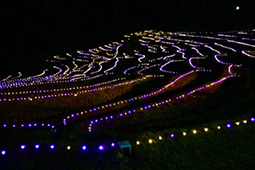INDEX
- English
- 日本語

Oyama Senmaida in Kamogawa City, Chiba Prefecture - English
- 日本語

Rice terrace owners and local farmers work together

Oyama Senmaida illuminated at night
November 2020
Working Together to Protect the Terraced Rice Fields

Rice cultivation in terraced rice fields created on the hillsides of mountainous regions has flourished in Japan since ancient times, although in recent years the area cultivated has been decreasing. In the terraced rice fields of Kamogawa City in Chiba Prefecture, local residents and urban dwellers work together to protect the scenic landscape and continue the practice of rice-growing.

Rice cultivation in Japan originally flourished mostly in terraced rice fields on slopes that offered a secure water supply, until advancements in irrigation technology in the seventeenth century enabled the development of new rice fields on plains. People cultivated mountain slopes and drew water from upstream mountain rivers into the rice fields, created reservoirs and dug wells to store water, and drew water from springs to secure and maintain the water supply needed for the rice terraces. In the Oyama Senmaida* Terraced Rice Fields in Kamogawa City, Chiba Prefecture, however, rice has been cultivated without river water using rainwater alone, a rarity in Japan, owing to the presence of clay soil with very high water-holding capacity. Rice produced in clay soil is sweet and sticky with excellent flavor, and is said to have been one of the highest quality rice grains available in the suburbs of Edo (present-day Tokyo) during the Edo period (1603–1867).
Terraced rice fields have a multitude of functions, such as preserving tradition and culture, offering scenic beauty, providing education, and ensuring national land conservation. This has led them to be likened to pyramids. The Oyama Senmaida are the closest terraced rice fields to Tokyo and comprise 375 rice paddies of various shapes and sizes spread across the steep, mortar-shaped terrain at an elevation of 90 to 150 meters. Less than two hours’ drive from the center of Tokyo, these scenic terraced rice fields evoking old Japan have recently become a popular tourist destination.
The mechanization of farming and the shift to large-scale agriculture has led to an increase in the number of abandoned terraced rice fields owing to their relatively low productivity. In response to this situation, the Oyama Senmaida Preservation Society, which was established in 1997 by landowners, Kamogawa residents, and people from out of town, has taken the lead in preserving the terraced rice fields and growing rice.
“Because the terraced rice fields are built on steep slopes, large machinery can’t access them so they rely on manual labor, and work efficiency is very low. So it was virtually impossible to make a living from rice farming alone. That’s why we decided to introduce the terraced rice field “owner system,” to maintain and manage the farmland through interaction between the local community and city residents,” says Ishida Mitsuji, Chairman of the board of directors of the Preservation Society.
Under the terraced rice field “owner system,” people who rent a terraced rice field (100 square meters) for an annual fee of 30,000 yen become “owners,” which allows them to perform farming tasks such as planting and weeding around seven times a year and harvest their own rice. In addition to farming tasks, the Preservation Society offers a variety of hands-on activities such as viewing nature and making rice cakes, which are popular with urban dweller owners as it enables them to learn about the traditional culture of a rural area.

In 2016, the Gonbei restaurant opened in a renovated 100-year-old farmhouse near the terraced rice fields, serving onigiri rice balls, rice noodles, and other local dishes using rice harvested from the terraced rice fields, conveying the appeal of the region’s rice food culture.
“When the Oyama Senmaida Preservation Society was first formed, most locals thought that city people would never pay to do farm tasks. However, when we started accepting applications for terraced rice field owners, it was more popular than we had anticipated and it filled up quickly. I think what we need to do now is engage in a variety of community revitalization activities with urban dwellers in addition to the preservation of the terraced rice fields.”
The terraced rice field “owner system” originating in the Oyama Senmaida has now spread to five areas in Kamogawa City. The efforts of the Preservation Society offer a hint for the future of rice farming in Japan: diversify the guardians of agriculture while passing on the beautiful rural landscape to the next generation.
* Literally translated, “Senmaida” means 1,000 rice paddy fields. “Sen” means 1,000, but it can also mean “many.” There are a lot of paddy fields called “Senmaida” in Japan, but they do not necessarily have 1,000 rice paddy fields.

